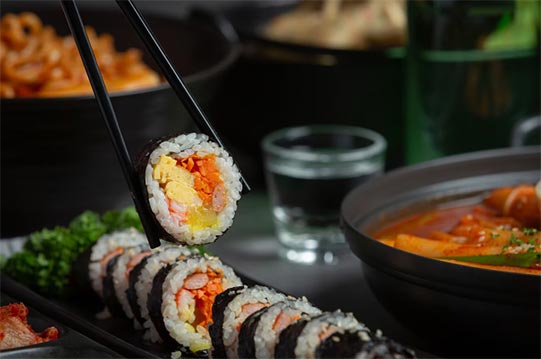 Trade Trends News
Trade Trends News
 23-10-2024
23-10-2024
South Korean food is thriving in China, with increasing exports of ramen and rice-based products, while the market share for cosmetics is declining.
Chinese consumers are spending more on South Korean food, while spending less on cosmetics and skincare products from the country.
Sunny Moon, research manager at Euromonitor International, stated, "China has a mature market for South Korean food. This trend is not limited to food. The environments and atmospheres depicted in Korean dramas—such as street food scenes featuring tteokbokki, corn dogs, fried chicken, and sweet and spicy fried chicken—are being commercialized."
According to South Korean media, in 2017, South Korean beauty products held the largest share among foreign brands in the Chinese cosmetics market. However, due to Beijing's export restrictions, South Korea’s cosmetics share dropped to fourth place by 2020. Last year, South Korea's brands fell from a 27% market share in 2017 to just 14.2%.
Meanwhile, South Korea's exports of food to China are rising. Data from South Korea's Ministry of Agriculture, Food and Rural Affairs shows that in the first nine months of this year, South Korea's food exports to China increased by 5.2% compared to the same period last year, reaching $1.1 billion. China is South Korea's third-largest market after Southeast Asia and the United States.
Ramen is especially popular among Chinese consumers. Data shows that as of September, exports of instant noodles grew nearly 20%, reaching $181 million, with China becoming the largest overseas market for these products.

During the same period, exports of processed rice products, such as pre-cooked frozen kimbap, pre-cooked rice products, and spicy stir-fried rice cakes, rose by 24% to $6 million. Total exports of these products hit a new record of $217.9 million by September, surpassing last year's $217.2 million.
The ministry stated last week, "Exports of rice processing products are expected to increase, as these products have entered global online platforms and major retail stores in China."
The surge in demand for South Korean food in China coincided with the South Korean government easing restrictions on Korean content after deploying a U.S.-made missile defense system in 2017.
South Korea claims that the Terminal High Altitude Area Defense (THAAD) system is aimed at deterring threats from North Korea. However, China views it as a security risk that could be used for military surveillance.
This unofficial ban led to the absence of South Korean dramas and stars from Chinese television and media platforms. In 2021, an agreement between China’s national broadcaster and a South Korean company marked a relaxation of these restrictions, allowing Korean stars to meet their Chinese fans again.
According to the official media outlet Global Times, over 20 K-pop groups, including NewJeans, Le Sserafim, and EXO, held fan signing events in cities like Beijing, Guangzhou, and Qingdao in January.
Since Hong Kong and Macau remain open to South Korean concerts and events, Chinese fans continue to find opportunities to watch their idols perform or meet them.
"The market for services, accessories, and other industries tied to cultural experiences from South Korean dramas is growing steadily," said Moon. "This indicates a broader trend where South Korea’s cultural influence shapes not only food and fashion but also paves the way for new business opportunities across a wider consumer base."
Hong Kong-based cosmetics retailer Sa Sa International remains confident in the sales of South Korean beauty brands in China.
Sa Sa's Executive Director and CFO, Ho Chi Keung, commented, "The popularity of Korean culture has been sustained for some time and continues to maintain strong momentum in the region. In recent years, new brands from South Korea have led growth in niche markets, appealing to Generation Z's demand for personalized products."
Ho noted that sales in the department, including lip gloss, setting sprays, cotton pads, and niche perfumes, have seen modest growth, adding that this is the second-largest source of sales.
He emphasized that this advantage is especially clear in skincare products, and he expects sales of South Korean brands to grow in the coming years.
However, not everyone is confident in a sustained rebound for South Korean cosmetics in China.
Sowmya Srinath, consulting director at Frost & Sullivan, remarked, "The 'Korean Wave' appeal in the beauty sector has waned," predicting a moderate decline in South Korean beauty products sales in China.
"South Korean brands once dominated the mid-range beauty market but are now being replaced by competitive Chinese products," Srinath said. "Efforts by leading South Korean brands to reshape their marketing and positioning in China may help stabilize their presence to some extent."
South Korea's exports of food products are steadily growing, but its beauty products face increasing competition, signaling a shift in how South Korea's influence on Chinese consumer preferences is evolving.
I. Establish Customer Resource Database by Country
The establishment of a customer resource database is akin to a personalized work record. Start by using trade tracking functionality to compile a list of all customers in a country. Then, analyze each buyer's purchase volume, procurement cycle, product specifications, and supplier system. Pay special attention to the diversification or singularity of a buyer's supply channels, as buyers with diverse supply sources are preferable. Finally, filter out 30% of the potentially high-quality customers from that country and record them in your customer resource database. The database can be flexibly organized by country, time, customer name, follow-up steps, contact phone, email, contact person, etc. (>>>Click to Develop New Customers)
II. Establish Customer Resource Database by Peer Companies
Have a good understanding of the English names (including full names, abbreviations, etc.) of peer companies. Utilize the global supplier networking feature to compile a list of all customers associated with these peer companies. The critical step is to analyze customers from these peer companies based on purchase volume, procurement cycle, product models, etc. Finally, filter out key customers from your identified peers and record them in your customer resource database. (>>>Click to Apply for Free Trial)
III. Identify Newly Appeared Customers in Each Country
Use the trade search function to identify customers newly appeared in a country. Choose the country, set the date range, limit the product name or HS code, and check the "Newest" option. The search results will display high-quality customers that have newly emerged in that country within the specified time frame. Since these customers are new, they may have just started transactions, and the stability of their suppliers may be uncertain. It's essential to focus on following up with these new potential buyers and record them in your customer resource database. (>>>Click to Apply for Free Trial)

These three approaches for developing customers using customs data can be implemented based on the actual needs of the company and oneself. Consider the market environment, industry characteristics, strategic requirements, etc., to find a suitable method. The ultimate goal is to establish and organize a categorized archive of high-quality customers. Once you identify suitable customers, the next step is to precisely contact them through various channels, such as phone calls, emails, and SNS information.
Category
Leave Message for Demo Request or Questions


 T-info
T-info T-discovery
T-discovery

 My
Tendata
My
Tendata Market Analysis
Market Analysis Customer
Development
Customer
Development Competitor
Monitoring
Competitor
Monitoring Customer Relationship
Customer Relationship





































































































































